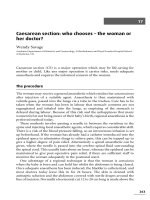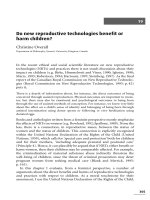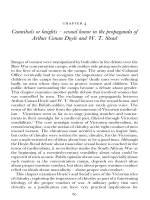Personal or distinctive a
Bạn đang xem bản rút gọn của tài liệu. Xem và tải ngay bản đầy đủ của tài liệu tại đây (160.22 KB, 22 trang )
Unit 22 (Unidad 22)
Personal or distinctive a
(La preposici
´
on “a” con
el complemento directo)
Level 1
1.1 Personal a when used for persons (La preposici
´
on a con un complemento
directo)
1.2 Personal a when used with collective nouns (La a con nombres colectivos)
1.3 Personal a when used with animals (La a con animales)
1.4 Personal a when used with proper names (La a con nombres propios)
1.5 When personal a is
not used (Cuando no se usa la a)
1.1 Personal a when used for persons
In English, the distinction between a noun as subject and a noun as object is shown by
its location in the sentence. In John reads the book, John is the subject and book is the object.
John comes before book.InLatin, this was shown by what we call case endings; that is to
say the endings of words changed according to their relationship with each other, and
word order was not so important. In Spanish, and much more than in French or English,
but similar to Italian, location has about as little effect on the meaning as in Latin. Many
Spanish speakers can find themselves therefore in considerable difficulty in distinguishing
between subject and object, and do not always succeed as clearly as we do in English or
French.
The only device in Spanish for distinguishing a noun as direct object when refer-
ring to persons is by placing the preposition a before it. But, as the preposition a is
regularly used for the indirect object (Le doy el libro a Juan = I give the book to Juan),
most Spanish speakers end up not knowing whether the preposition a involves a direct
or indirect object. In other words, they often fail to see the difference between Veo a
Juan (I see Juan) and Le doy el libro a Juan.They think erroneously that Juan in Veo a
Juan is an indirect object. The situation is further complicated because they do not have
a suitable descriptive equivalent for what we call the “personal a.” French or Italian
speakers do not have an equivalent expression either. The expression “personal a”in
English therefore helps us over a very difficult hurdle. Here are the main uses of the
“personal a.”
198
22 Personal or distinctive a
1.2 Personal a when used with persons and collective
nouns
i The personal or distinctive a applies primarily to nouns representing determinate,
known persons:
Veo a Pedro I see Pedro
Busco a la chica Iamlooking for the girl
Quiere visitar a mi hija He wants to visit my daughter
Lleva a sus hijos a la estaci´on She takes her children/sons to the station
ii If the personal noun is collective, the personal a is often, but not always, used.
However, it is safer always to use it in these circumstances:
Ana mima a su familia Ana spoils her family
Llaman a la polic´ıa They call the police
El pol´ıtico critica al gobierno The politician criticizes the government
iii The application of the personal a extends to authors, painters, etc., i.e. all those in
the public domain:
Leo a Cervantes con frecuencia Iread Cervantes regularly
Imita a Diego Rivera He copies Diego Rivera
El p´ublico aplaude a la estrella The audience applauds the star
La empresa despide a cinco obreros The company dismisses five workers
1.3 Personal a when used with animals
When the direct object noun represents an animal, regarded as intelligent or rational,
and especially if it belongs to a family, the personal a is required:
Llaman al perrito They call the dog
Se pasa un rato acariciando al gato She spends some time stroking the cat
1.4 Personal a when used with proper names
The personal a is also needed before proper names of persons:
Env´ıo a Diego en su lugar I’ll send Diego in her place
Admira a Andr´es She admires Andr´es/Andrew
1.5 When personal a is not used
(But see level 2.3.)
The personal a is not used when the object is an insignificant animal, or an inanimate
object:
El gato agarra (M)/coge (not in M)unrat´on Thecat catches a mouse
El ni˜no persigue una mariposa Thechild chases the butterfly
Como la carne Ieatthe meat
199
ASTUDENT GRAMMAR OF SPANISH
Exercises
Level 1
i Change as in the example
Esperamos a Jorge (Mar´ıa/elni˜no) > Esperamos a Mar´ıa/alni˜no
a Vemos a los muchachos (Luisa / los se˜nores / Manuel / la maestra / las ni ˜nas / los
pajaritos)
b Llevan a las chicas (sus amigos / la ni˜na / Carlos / las muchachas)
c Necesitas a Juan (el doctor / mis amigas / el muchacho / los alumnos)
d Oigo a los ni˜nos (la muchacha / Jorge / mis cuates [M]/elbeb´e/elgato)
e Traemos a nuestros amigos (nuestros pap´as [M]/miabuela / tus primas / los
perritos)
ii Paired activity
Objective –Topractice the use of the personal a
Method –AgivesBaverbandanoun as a direct object. B has to make a sentence with
the verb and the noun, using the personal a when necessary. If A is smart enough, (s)he
will provide some nouns where the a is not used. So B, be careful! (¡cuidado!)
Examples
A: Ver + mujer
B: Veo a la mujer
A: Admirar + pianista
B: Admiro al / a la pianista
A: Golpear + pared
B: Golpeo la pared
Here are some verbs and nouns A can use:
leer, contar, llevar, buscar, lavar, preparar, llamar, ayudar, contestar, preguntar, querer,
observar, preferir, conocer, tocar, limpiar, avisar hombre, m´edico/doctor, enfermera,
profesor, peri´odico, platos, gesto, ciudad, flores, guitarra, rec´amara (M)/habitaci´on,
amigo/a, familia, t´ıo, maestro, vecinas, polic´ıa
Afterwards, you all gather together to discuss your sentences.
Level 2
2.1 Use and non-use of personal a (Uso y omisi
´
on de a)
2.2 Use of personal a with personification (Uso de a con personificaci
´
on)
2.3 Omission of personal a (Omisi
´
on de la a)
2.4 Personal a used with direct and indirect objects (Uso de a con objetos directo e
indirecto)
2.5 Miscellaneous features (Varios detalles)
2.6 Personal a with nadie, alguien, quien (La a con nadie, alguien, quien)
2.7 More possible confusion over the personal a (Posibilidad de m
´
as confusi
´
on con
la a)
200
22 Personal or distinctive a
2.1 Use and non-use of personal a
In all cases, the employment of the personal a before a direct object denoting a person
depends largely on how the speaker views the person. In other words, if the speaker
knows the person referred to, (s)he will use the personal a,but if the person alluded to is
not known, the a is not often used. Compare these two sets of cases:
Busco al doctor Iamlooking for the physician/doctor
Busco un doctor Iamlooking for a physician/doctor
Estoy esperando al cliente I’m waiting for the client
Estoy esperando un cliente I’m waiting for a client
It is of course conceivable that in all these cases a is used, but the further away the object
is, figuratively speaking, the less likely it is that the personal a is used.
2.2 Use of personal a with personification
When the direct object is personified, the personal a is frequently, but not always, used.
Particularly common here is the use of patria, naci
´
on and pueblo, especially the latter,
which contains a suggestion of human beings:
Estos soldados honran a la patria These soldiers honor the nation
Juraron defender a la naci´on They swore to defend the nation
Las nuevas medidas pretenden contentar al pueblo The new measures aim to satisfy the people
Las aves saludan a la Aurora The birds salute the Dawn
NB Once, towns and countries were included in this category, but this is
no longer the case.
2.3 Omission of personal a
i The personal a is omitted when it would conflict with another a which has a true
prepositional value:
El general convoc´o los oficiales a una conferencia The general called the officers to a
conference
Compare the two following sentences:
Abandonaron al hombre They abandoned the man
Abandonaron el hombre a sus remordimientos They abandoned the man to his remorse
ii When the verb has a direct and indirect object, the direct object does not take the
personal a, thus avoiding confusion or ambiguity:
Recomend´oalgobernador su hijo, Don Jos´e He recommended his son, Don Jos´e, to the
governor
201
ASTUDENT GRAMMAR OF SPANISH
Presentar´emihermana a la se˜nora de Vargas I’ll introduce my sister to Sra Vargas
El soldado entreg´osuprisionero al capit´an The soldier handed over his prisoner to the
captain
2.4 Personal a used with direct and indirect objects
When both subject and object denote things, the object takes the personal a. Otherwise,
confusion and ambiguity would arise. We are now in the realm of word order (see
unit 29). Compare the following four sentences:
El silencio (subject) sigue al ruido (object) Silence follows the noise
Al ruido (object) sigue el silencio (subject) Silence follows the noise
El ruido (subject) sigue al silencio (object) Noise follows the silence
Al silencio (object) sigue el ruido (subject) Noise follows the silence
Compare likewise the following four sentences. (From the first four sentences above, you
can work out the subject and object in each sentence below.)
El yate alcanzar´aalvapor Theyacht will overtake the steamer
Al vapor alcanzar´aelyate Theyacht will overtake the steamer
El vapor alcanzar´aalyate The steamer will overtake the yacht
Al yate alcanzar´aelvapor The steamer will overtake the yacht
2.5 Miscellaneous features
i When one of the terms is a person, which is usually the case, danger of ambiguity
does not arise, because the person as object is accompanied by a.
Compare the two following sentences:
Porfinvenci´oeljoven (subject) su pasi´on (object)
por el juego
Theyoung man finally overcame his passion
forgambling
Porfinvenci´oaljoven (object) su pasi´on (subject)
por el juego
The passion for gambling finally overcame
the young man
ii Verbs of naming, calling, considering, etc., which may take two direct objects
differentiate one of these objects by the personal a in the following way:
¿Llaman m´usica a este jaleo? Do they call this ruckus music?
Consideramos pura p´erdida de tiempo a la lectura de
estas revistas
We consider the reading of these magazines
a pure waste of time
The true object, or thing asserted, in the first case, jaleo, and in the second case, lectura,
is preceded by the personal a.
2.6 Personal a with nadie, alguien, quien
The personal a is always used before alguien, nadie and quien when these words
function as direct objects, even though they may suggest uncertainty over the person
referred to:
202
22 Personal or distinctive a
¿Vas a invitar a alguien? Are you going to invite someone?
No veo a nadie I can’t see anyone
¿A qui´en llamas? Whom are you calling?
2.7 More possible confusion over the personal a
To return to the confusion generated by the personal a, personal pronouns are a special
case in point. Again, it is difficult for Spanish speakers who are not language conscious
to know whether the following examples include pronouns (le, les)asindirect objects or
direct objects, largely because, in order to stress the pronoun, a disjunctive form of it is
used before the verb:
A´el le interesa el libro The book interests him
A ella le encanta la ´opera She loves opera
A ellas les atrae la idea de... They are attracted by the idea of...
This issue is further complicated by the following two examples based on the reflexive
se (see the use of reflexives in unit 14, level 2).
Se vio el hombre en el espejo The man saw himself in the mirror
Se le vio al hombre en el espejo The man was seen in the mirror
Here, the reflexive se dispels any ambiguity over who is seeing whom.
Exercises
Level 2
i Sustituye un nombre por un pronombre como en el ejemplo. Puedes elegir cualquier
nombre (noun)acondici ´on de que sea una persona. Puede haber una gran variedad
de respuestas
Los/les oigo > Oigo a los alumnos
a Los necesito g ¿Los acoges?
b Las ven h Las traigo
c ¿La quieres? i ¿Las oyes?
d Los o´ımos j No lo/le entiendo
eLaest´an esperando k Los llevo a todos en mi carro
fLorecibo l Los admiramos
ii Pon las siguientes palabras en su orden correcto. Ten en cuenta que faltan la
preposici ´on a y los art´ıculos definidos en la mayor´ıa de los casos, y que te toca
insertarlos en su lugar correcto cuando sea necesario, y que puede haber m ´as de una
soluci ´on
Ejemplos
atac´ole´on tigre > El tigre atac´oalle´on / Elle´on atac´oaltigre/Alle´on le atac´oeltigre /
Al tigre le atac´oelle´on
ver familia quer´ıa hija > La hija quer´ıa ver a la familia / La familia quer´ıa ver a la hija
a verbo pronombre sigue
b doctor hallamos (M)sepa hijo nuestro un curar que no
c ver quer´ıa su esposa sus hijos y
203
ASTUDENT GRAMMAR OF SPANISH
d ganso pel´o cocinera
e tres mataron faisanes ciervos dos y
f caballo comprar quisiera yo un
g vender quer´ıa su caballo ´el
h director hija Mar´ıa presentaron su
i hijos colegio llevaba sus la madre
j carro carro (M)r´apido lento rebas´o(M)
k gato perro persigue
l juez no pol´ıtico sobornar pudo
m qui´en saber llamaba quer´ıa
n nadie yo ve´ıa no
o le en si conoc´ıa pregunt´e colegio alguien
iii Actividad en parejas
Objetivo – Practicar el uso de “a” con nombres como objeto directo
M
´
etodo –Seles elige a dos miembros de la clase. Escriben en el pizarr´on (M) / la
pizarra seis series de palabras mezcladas que contienen un verbo y un objeto directo que
es una persona. Omiten adrede (deliberately)laa. Intentar no crear frases largas (seis o siete
palabras como m´aximo). La clase tiene que reconstruir la frase, poni´endo las palabras
en su orden correcto y a˜nadiendo la a en su lugar apropiado.
Ejemplos
Se escribe en el pizarr
´
on: consulta madre mi m´edico el
La clase reconstruye: Mi madre consulta alm´edico
Se escribe en el pizarr
´
on: amiga tu francesa conocemos
La clase reconstruye: Conocemos a tu amiga francesa
Se escribe... carro hombre el el maneja
La clase... El hombre maneja el carro
(no a here)
Se le corresponde al profesor intervenir si quiere.
204
Unit 23 (Unidad 23)
Prepositions (Las preposiciones)
Level 1
1.1 The basic prepositions (Las preposiciones b
´
asicas)
1.2 Uses of a (Usos de a)
1.3 Uses of ante (Usos de ante)
1.4 Uses of bajo (Usos de bajo)
1.5 Uses of con (Usos de con)
1.6 Uses of contra (Usos de contra)
1.7 Uses of de (Usos de de)
1.8 Uses of desde (Usos de desde)
1.9 Uses of durante (Usos de durante)
1.10 Uses of en (Usos de en)
1.11 Uses of entre (Usos de entre)
1.12 Uses of excepto (Usos de excepto)
1.13 Uses of hacia (Usos de hacia)
1.14 Uses of hasta (Usos de hasta)
1.15 Uses of mediante (Usos de mediante)
1.16 Uses of salvo (Usos de salvo)
1.17 Uses of seg ´un (Usos de seg ´un)
1.18 Uses of sin (Usos de sin)
1.19 Uses of sobre (Usos de sobre)
1.20 Uses of tras (Usos de tras)
1.1 The basic prepositions
The simplest use of prepositions is to express the relations of things to each other with
respect to time and place. Such prepositions in English are in, out, before, under, over.
They extend, however, to many other relations, and especially to the relations between
adjectives or verbs and the nouns or pronouns to which they apply.
There are two sorts of prepositions in Spanish: simple and compound. The simple
ones will be treated in level 1, while the compound ones will be dealt with in level 2,
together with more complex expressions.
The simple prepositions are:
a at, to, in hacia towards, about, for
ante before hasta until, to, up to
205









